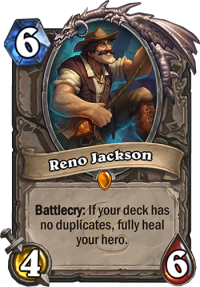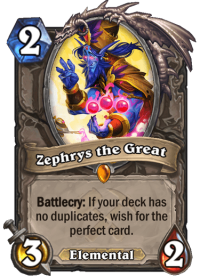With Zephrys the Great making waves across basically every class and decks of every archetype, it’s clear that the card is much more versatile than any of the previous tools that required you to have no more than a single card in your deck – so much so that many opt to run it even with duplicated as a potential late-game bomb. This isn’t the only reason why the Highlander tools from Saviors of Uldum produced very different “Reno” decks than the ones we’ve seen in the past: the nature of the payoff on the class-specific ones also promote a very different kind of gameplay than what we’ve seen in the past.
Out of The Hall of Explorers

The original introduction of the “Highlander” criterion – a requirement that you can only feature singletons in your deck – came all the way back in November 2015 with the release of the League of Explorers adventure. Reno Jackson’s original form was the only card in the set with this condition, a massive heal meant to compensate for the early-game tempo loss to allow you to stabilize later down the line. Since combo decks couldn’t sacrifice the built-in redundancy of two-ofs, this effect basically set it in stone that Highlander decks have to be control-oriented until Reno remains in the rotation. (In fact, the archetype was almost always referred to as “Reno decks” back then, but the terminology changed now that the new collection of such cards were added to the game.)
No singleton-requiring card was released for over a year as neither the Standard-kickoff Whispers of the Old Gods nor One Night in Karazhan pushed the archetype further – however, Mean Streets of Gadgetzan more than made up for it with four. Once again, both the class-specific cards and the tri-class Kazakus supported a slow gameplan with resource generation in mind. Though it has to be said that Legendary minion for Mage (Inkmaster Solia) and Warlock (Krul the Unshackled) were quite underwhelming – with many Reno builds cutting them across the classes –, the archetype was strong enough to become viable for each class that had Kazakus available to them. Priest, of course, eventually went on a complete tear due to the interaction between Raza the Chained (which originally reduced your hero power to 0 mana) and Shadowreaper Anduin – generating endless removal and damage output and propelling it to one of the strongest decks in the history of the game –, but the Highlander builds were already viable in the MSoG meta, generating an insane amount of value against Mages and putting up a strong defensive toolkit to go up against aggro decks, most notably Pirate Warrior.
No Highlander card was released since then, and no other such archetype had room to emerge in the intervening period – until now. Notably, no deck other than the aforementioned Razakus archetype managed to make things work without the stabilizing heal effect of Reno Jackson – and Priest was uniquely well-suited to replicate the effect with Spirit Lash and spell damage, Greater Healing Potion and its starting hero power –, which necessitated a very different approach when designing the new Highlander cards for the glorious return of the League of Explorers in Saviors of Uldum.
Your Wish is My Suggestion

For starters, all but one of the classes with strong Highlander support in this expansion were ones that haven’t had such cards available them in the past. Apart from Mage, none of Paladin, Hunter or Druid had such decks available them (though Lifecoach did have a few failed experiments with the first one on the list way back when). The class-specific tools are also much more diverse this time around, allowing for strategies that don’t revolve around resource generation. Dinotamer Brann works well in a flexible tempo-based deck, Elise the Enlightened also allows for combo potential, Sir Finley of the Sands can be partially tailored to any gameplan (though its potential remains mostly unexplored for now) and Reno the Relicologist is a pure removal tool.
The fact that you can play different archetypes across the classes with Highlander support is a great boon to the gameplay experience – though the card that mixes things up the most is Zephrys the Great, a very different utility option than Reno Jackson used to be…
The dastardly djinn is basically as close as we’re ever going to get to a Jolly Joker in Hearthstone, a card which can give you a board clear or a lethal buff when you need it, with a plethora of options in-between. As it turns out, a tool to deal with repetitive damage from the board is just as effective as a recovery option as a huge heal is without the ability to interact with your opponent’s minions, and its potential is much greater in other matchups than Reno’s ever was.
In fact, the flexibility and power level of the card makes it a reasonable option to experiment with Highlander decks across the classes which didn’t get a member of The League of Explorers to play around with, which is a great development as the deckbuilding potential of such archetypes is huge, potentially allowing for innovation deep into any given metagame. Highlander decks also take a lot longer to settle on the best possible list (if there is even one specific one to emerge), which is also great considering how quickly we’ve reached equilibrium over the course of the last few expansions.
The main discussion point about the card right now is that it has become a viable tool even in certain non-Highlander archetypes that can draw all heir cards enough consistency to trigger its effect. Right now, Quest Druid and Shirvallah Paladin are the main culprits, but their performances made it clear that Zephrys will be a very reliable tool in combo decks which intend to cycle through their whole deck going forward.
From a design perspective, it’s quite unlikely that Team 5 would re-word the Highlander criterion on just one card – it’s an inelegant solution with the potential to confuse new players. From a gameplay perspective, it remains to be seen how big an issue this will turn out to be. With mostly combo decks topping the winrate charts – and little to no aggro toolkit to counter them on an archetypal level –, we’ll have to wait and see how consistently can a non-Highlander deck trigger Zephrys’ effect in later metagames. One thing is for sure: no one even dreamed about playing Reno Jackson in a deck with duplicates.

[…] Article: Hearthstone’s New Highlander Decks Are Nothing like the Old Ones […]
“With mostly combo decks topping the winrate charts – and little to no aggro toolkit to counter them on an archetypal level –, we’ll have to wait and see how consistently can a non-Highlander deck trigger Zephrys’ effect in later metagames.”
I find this sentence confusing. Since when are combo decks mostly topping the winrate charts? According to hsreplay and VS, Murloc Paladin is the only Tier 1 deck that could be considered a combo deck and runs Zephrys, and its “combo” isn’t even a one turn kill, it’s a repeated board flooding mechanism, which is normally considered aggro not combo. Other non-highlander decks that run Zephrys are Quest Druid, which is more midrange than combo and isn’t Tier 1, and Holy Wrath Paladin, which isn’t a anywhere near Tier 1, but crops up in tournaments and at legend because it can take games off of particular decks. Meanwhile, the numbers show that if it weren’t for Control Warrior, Aggro Rogue, Aggro Warrior, and Zoo Warlock could all be among the top decks right now and Murloc Shaman and Paladin would be even stronger, and Control Warrior’s ability to shut them down has nothing to do with Zephrys.
I need this to be changed. With no one running weapon removal my cutglass rogue would rule the meta if it weren’t for zephrys discovering ooze.
Now I Just lose every game
Already tired of Zephrys plays across both formats. Don’t get me wrong, cool card (crafted it golden 😉 ), but the power spike is too high and most of the time, the outcome is pretty ‘boring’ (read: obvious).
Besides that, I’m not so sure I like the fact that a single card can turn bad matchups into good ones.
Highlander decks are my absolute favourite hearthstone decks, not always so consistent but so fun with so much variety.